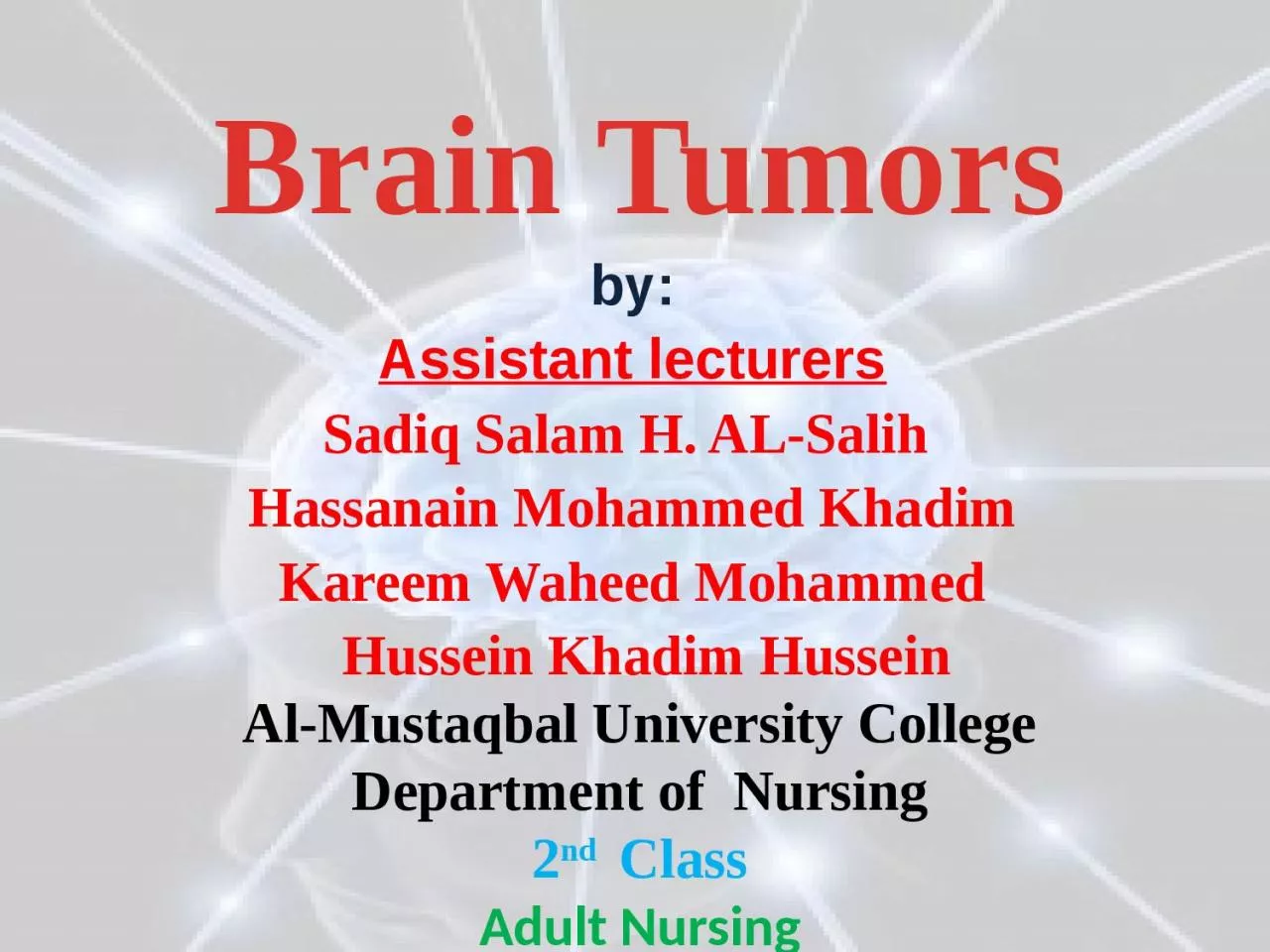

Sadiq Salam H AL Salih Hassanain Mohammed Khadim Kareem Waheed Mohammed Hussein Khadim Hussein Al Mustaqbal University College Department of Nursing 2 nd Class Adult Nursing ID: 930908
Download Presentation The PPT/PDF document "Brain Tumors :by Assistant lecturers" is the property of its rightful owner. Permission is granted to download and print the materials on this web site for personal, non-commercial use only, and to display it on your personal computer provided you do not modify the materials and that you retain all copyright notices contained in the materials. By downloading content from our website, you accept the terms of this agreement.
Slide1
Brain Tumors
:by
Assistant lecturers
Sadiq
Salam H. AL-
Salih
Hassanain
Mohammed
Khadim
Kareem
Waheed
Mohammed
Hussein
Khadim
Hussein
Al-
Mustaqbal
University College
Department of Nursing
2
nd
Class
Adult Nursing
Slide2Brain Tumor
Brain tumor
is an abnormal growth tissue in the brain.
Primary
brain tumors
originate from cells and structures within the brain.
Secondary
or metastatic
, brain
tumors develop from structures out side the brain and occur in 10% to 20% of patients with cancer.
Brain tumors rarely metastasize outside the CNS ,but metastatic lesions to the brain occur commonly from the lung ,breast, lower gastrointestinal
tract , pancreas and
skin(melanomas).
Slide3Types of primary brain tumors
Dural meningioma:
Tumors arising from the coverings of the brain
Acoustic neuroma:
Tumors developing in or on the cranial nerves,
An acoustic neuroma is tumor of eighth cranial nerve
, the cranial nerve most responsible for hearing and balance. The patient usually experiences:
1) loss of hearing,tinnitus,and episodes of vertigo and staggering gait.
2) As the tumor becomes larger,
painful sensation
of the face may occur on the same side, as result of the tumors compression of the
fifth cranial nerve
, most acoustic neuromas are
benign
,can be surgically removed ,and have a
good prognosis.
Slide4Glioma :
Tumors originating within brain tissue ,the most common type of intracerebral brain neoplasm, are divided into many categories.
Astrocytomas
are the most common type of glioma usually these tumors spread by infiltrating into the surrounding neural connective tissue and therefore cannot be totally removed without causing considerable damage to vital structures.
Oligodendroglial
tumors represent 20% of gliomas .
Pituitary Adenomas :
represent about 7% to 12% of all brain tumors and cause symptoms as a result of pressure on adjacent structures or hormonal change {hyper or hypo function of the pituitary}.
Angiomas
:
Metastatic lesions originating elsewhere in the body.(Masses composed largely of abnormal blood vessels),are found either in or on the surface of the brain.
Slide5Risk factors of the brain tumor
Being male
Race
Age
Family history
Being exposed
to radiation or certain chemicals at work
Slide6General
sign and symptoms of brain tumor
The
most common symptoms presented
by
1-
Increase intracranial pressure are
(ICP).
2-
Headache ; not persist and occur in early morning and increase in the intensity during strain such as coughing ,sneezing or sudden movement 3- Vomiting (projectile vomiting). 4- Papilla edema: - edema of the optic nerve associated blurring of vision and diplopia. 5- Stupor.
Slide7Local symptoms
Tumor of cerebellum cause.
Dizziness
Staggering gait with tendency to fall toward the side of lesion (ataxia).
Muscle incoordination.
Nystagmus (involuntary) jerking movements of the eyes.
Slide8Local symptoms
Tumor of frontal lobe.
Personality disorder.
Lose of thought or disturbing of thought.
Lost of memory or disturbing of memory.
Disturbing in the behavior.
Tumor of temporal lobe
Impairment
of speech
Slide9Local symptoms
Tumor of posterior fossa.
Disturbances of C.N such as
loss of hearing,
Facial paralysis.
Impairment sensation over face.
Slide10Local symptoms
Tumor of parietal
Numbness then weakness in the opposite side of the body
.
Unable to know the think (object) by touch.
Tumor of left parietal lobe lead to aplasia in patient with right hand.
Slide11Diagnosis of brain tumor
Physical exam
Neurological examination
Brain CT scan
MRI on brain
Angiogram
Spinal tap
Biopsy
PET scan
EEG
: The test records the electrical activity in your brain. It is often done if there are seizures. Angiogram: This test looks at the blood vessels in the head. It is done if the tumour is close to a blood vessel
Slide12How is a Brain Tumor Treated
Treatment depends on type of tumor
More than one treatment may be used
Surgery
Radiation therapy
Chemotherapy
Rehabilitation
Targeted therapy
Supportive care
Slide13Supportive Care
To help prevent or control symptoms and improve patient’s comfort during treatment
Steroids
Anti-seizure (convulsant) medication
Shunt
Anti-depressants
Slide14Brain Cancer Prevention
1-
Avoid exposure to harmful environmental chemicals
2-
Eat a well-balanced diet that include essential
nutrients
3-
regular
Exercise
4- Quit smoking5-Limit alcohol consumption6- Get regular check-up for screening
Slide15Nursing diagnosis
1-Self-care deficit (feeding, bathing, and toileting) related to loss or impairment of motor and sensory function and decreased cognitive abilities.
2-
Imbalanced nutrition, less than body requirements related to cachexia due to treatment and tumor effects , decreased nutritional intake, and malabsorption
3-
Anxiety related to fear of dying, uncertainty, change in appearance, or altered lifestyle.
4-
Interrupted family processes related to anticipatory grief and the burdens imposed by the care of the person with a terminal illness.
5-
Acute
pain related to tumor compression6- Impaired gas exchange related to disease process;7- Constipation related to decreased fluid and dietary intake and medications;
Slide16Planning and Goals
The goals for the patient may include :
1-
compensating for self-care deficits
.
2-
Improving nutrition
.
3-
Reducing anxiety.
4- Enhancing family coping skills. 5- Absence of complications.
Slide17THANK YOU